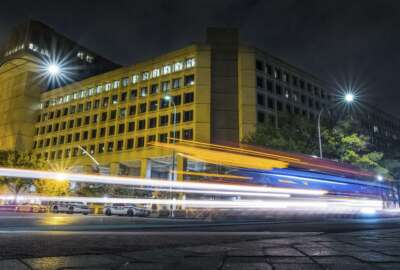The General Services Administration, the federal government’s landlord, sees a major opportunity to scale back the amount of office space that agencies use.
GSA Administrator Robin Carnahan told the House Oversight and Accountability Committee on Tuesday that her agency is “laser-focused on right-sizing the federal footprint.”
Many federal employees have been heading back to the office more regularly this fall, or in the coming months, after the Office of Management and Budget directed agencies to increase “meaningful” in-office work.
But with agencies — including GSA — embracing the benefits of a long-term hybrid and remote workforce, Carnahan said her agency sees an opportunity to reduce the government’s real-estate footprint by up to 30% in the coming years.
Shrinking the federal office space portfolio to that degree, she added, would save the federal government about $60 billion over a decade.
“Right now, agencies across the government are rethinking how much space they actually need. And while GSA doesn’t make space decisions for agencies, we do work closely with them to leverage our team’s expertise to help agencies plan and whenever possible to downsize,” Carnahan told the committee.
About half of GSA’s leases are set to expire within the next five years.
“I think there’s a huge opportunity at this moment to both get out of leases. That saves a lot of money, billions of dollars, and get out of unneeded buildings, also saving billions of dollars,” Carnahan said.
Agencies spend about $2 billion annually to operate and maintain federal office buildings.
To consolidate and shrink federal office space, Carnahan said GSA needs Congress to fully fund its fiscal 2024 budget request. That includes giving the agency full access to the Federal Buildings Fund.
Congress since 2011 has diverted about $1 billion each year from the Federal Buildings Fund to cover other agencies’ budgets.
Carnahan said Congress siphoning off these funds has delayed investments in federal buildings, and limited opportunities for agencies to consolidate office space.
“Consolidating agencies and disposing of buildings can only happen if we have modern functional space for agencies to relocate into,” she said.
“You can’t get rid of the old building that you know is going to save you a lot of money, if there is not a way to upfront have money to invest in the improvement of the one you’re going to keep,” Carnahan said.
Nina Albert, the former commissioner of GSA’s Public Buildings Service, told the Senate Environment and Public Works Committee in September that agencies, over nearly the past decade, missed as many as 120 opportunities to consolidate federal office space, “representing hundreds of millions in annual savings that have been missed due to lack of available funding.”
“Bottom line, we have missed opportunities to shrink our real estate portfolio because we haven’t had the upfront money to reconfigure and modernize facilities that we plan to keep, even though we know that those investments will pay back many times over through lower real estate costs,” Carnahan said.
GSA is already stepping up efforts to offload federal buildings and properties that agencies no longer need. Last week, it announced it’s putting 23 additional federal properties through its disposition process.
The next steps include selling, transferring, or exchanging them to another federal agency, or state or local government, or to the public.
Those properties, if sold, would eliminate 3.5 million square feet from the federal government’s real estate portfolio, and a $1 billion cost avoidance over 10 years.
“This is just the beginning, and we want to do more of that,” Carnahan said.
Carnahan said that GSA faces long-term planning challenges without budget certainty.
“Particularly when we’re maintaining buildings, we have to have a plan. We’ve got the biggest commercial real estate portfolio in the country. They’re all in a different state of need. And we need to be able to have plans to address those things. And the only way you do that is with some certainty,” Carnahan said. “Not having clarity about what a budget is going to be, and kicking the can down the road to the next year doesn’t make the costs go down. It makes the cost go up.”
Congress is looking to pass a continuing resolution to avoid a government shutdown on Friday.
GSA shrank its office space footprint by 43% over the past 10 years, and saved about $300 million in real estate costs.
About 40% of GSA’s workforce of 12,000 employees are fully remote.
Carnahan said in the past three years, GSA has seen its volume of business grow by 38%. During that same period of time, GSA has seen its customer satisfaction scores grow from 3.0 to 3.9 – on a scale of 1 to 5.
”Those are the metrics that really matter and we pay close attention to,” Carnahan said.
She added 75% of GSA’s workforce is outside of Washington and 75% of its assets are outside of Washington.
“Our teams are scattered around the country. And frankly, I think that is good for the American people and good for delivering the kind of service folks could expect,” Carnahan said.
To make better use of its headquarters space, Carnahan said GSA is setting aside an entire wing of its headquarters for the presidential transition.
“We decided that we could use our own space and convert that and be able to save a lot of money in that way. Because the building wasn’t fully occupied,” she said.
Since 2013, GSA has reduced the federal footprint by disposing of 12 million square feet of owned space and giving up 18 million square feet of leased space.
But committee Chairman James Comer (R-Ky.) said GSA is still spending hundreds of millions of dollars to maintain government-owned properties that are underutilized and should be sold off.
Federal Property Management has long been on the Government Accountability Office’s High-Risk List, but Comer said “it’s now become one that is just simply too big and too costly to ignore.”
“The Biden administration can’t have it both ways at taxpayers’ expense. You either bring employees back to work to improve productivity and service or you fully right-size the office space,” Comer said.
Carnahan also defended her agency’s decision last week to build a new FBI headquarters in Greenbelt, Maryland.
Committee members, however, are making a bipartisan push for GSA’s inspector general to review the FBI headquarters decision.
Rep. Scott Perry (R-Pa.) said lawmakers need a review from an independent third party — not GSA’s Office of Legal Counsel, which reports to Carnahan.
“We don’t see that as meaningful, because they work for you. If you’ve got an independent review, maybe we’d see that as somewhat meaningful, but all these people work for you,” Perry said.
Rep. Gerry Connolly (D-Va.) told Carnahan GSA officials “really risk damaging the credibility of the agency, and its sense of fairness and lack of political interference and decision making.”
Copyright
© 2024 Federal News Network. All rights reserved. This website is not intended for users located within the European Economic Area.





